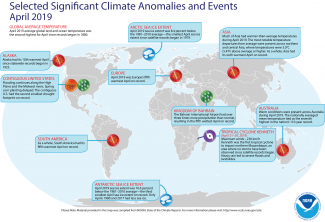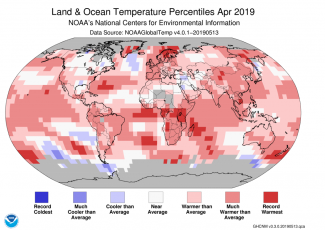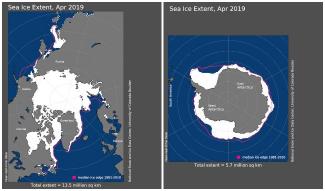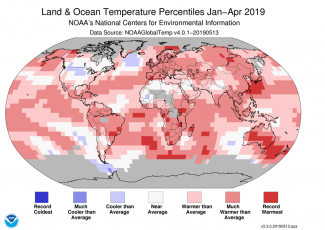Second warmest April global temperature on record

The global land and ocean surface temperature departure from average for April 2019 was the second highest for the month of April in the 140-year NOAA global temperature dataset record, which dates back to 1880. The year-to-date temperature was the third warmest January–April on record.
This monthly summary, developed by scientists at NOAA National Centers for Environmental Information, is part of the suite of climate services NOAA provides to government, business, academia and the public to support informed decision-making.
April Temperature
-
The April temperature across global land and ocean surfaces was 1.67°F above the 20th century average of 56.7°F and was the second highest for April in the 1880–2019 record, behind 2016 (+1.94°F).
-
This was the 412th consecutive month and the 43rd consecutive April with temperatures, at least nominally, above the 20th century average. The global land and ocean temperature for April 2019 tied with September 2015 as the 11th highest monthly temperature departure from average among all months (1,672 months) on record.
-
Record-warm April temperatures were present across parts of Greenland, Scandinavia, the Barents Sea, the Atlantic Ocean, western Indian Ocean, central Africa, Asia, and the southern Pacific Ocean. No land or ocean areas had record-cold April temperatures.
-
-
The April globally averaged land surface temperature was 2.66°F above the 20th century average of 46.5°F. This value tied with 2012 as the third highest April land temperature in the 140-year record, trailing behind 2016 (+3.40°F) and 2007 (+2.70°F).
-
The most notable warm land surface temperature departures from average during April 2019 were present across Greenland, Scandinavia and northern and central Asia, where temperatures were at least 5.4°F higher than average. The most notable cool temperature departures from average were present across Canada and the southern ocean off the southern coast of Australia, where temperature departures from average were 1.8°F below average or cooler.
-
Regionally, South America, Europe, Africa, Asia and Oceania each had a temperature that ranked among the nine warmest for April on record. Meanwhile, the Caribbean region had its least warm April since 2012.
-
-
The April globally averaged sea surface temperature was 1.30°F above the 20th century monthly average of 60.9°F — tying with 2017 as the second highest global ocean temperature for April on record. Only April 2016 was warmer at +1.42°F. The five warmest April global ocean temperatures have all occurred since 2015.
Sea Ice and Snow Cover
-
April 2019 marked the 18th consecutive April with Arctic sea ice extent below average. This was the smallest Arctic sea ice extent for April in the 41-year record at 479,000 square miles (8.4%) below the 1981–2010 average and 89,000 square miles below the previous record low set in April 2016, according to an analysis by the National Snow and Ice Data Center using data from NOAA and NASA. Rapid ice loss, of about 50%, through mid-month in the Sea of Okhotsk contributed to the record low extent. Additionally, sea ice extent was below average in the Baffin Bay, Barents Sea and Bering Sea. For a third consecutive month, the Bering Sea had near-record low sea ice extent at 66% below average, trailing behind April 2018 (76% below average).
-
April 2019 marks the third consecutive April that the Antarctic sea ice extent was below average at 440,000 square miles (16.6%) below the 1981–2010 average. This was the third smallest April extent in the 41-year record. Only Aprils 1980 (-21.2%) and 2017 (-20.6%) had less sea ice extent.
-
According to data from NOAA and analyzed by the Rutgers Global Snow Lab, the Northern Hemisphere snow cover extent during April was 450,000 square miles below the 1981–2010 average. This was the 12th smallest snow cover extent in the 53-year record. The Eurasian and the North American snow cover extents were the 13th and 19th smallest on record, respectively.
Year-to-date (January–April 2019)
-
The year-to-date temperature across global land and ocean surfaces was 1.62°F above the 20th century average of 54.8°F — the third highest for January–April in the 140-year record, behind the years 2016 (+2.07°F) and 2017 (+1.71°F). The five highest January–April global land and ocean temperatures have occurred since 2010.
-
The most notable warm temperatures during the year-to-date period were present across Alaska, northwestern Canada and central and eastern Russia. The January–April 2019 temperatures across these regions were 6.3°F above average or higher. The most notable cooler-than-average temperatures was present across much of Canada and the north-central contiguous U.S, where temperatures were 3.6°F below average or cooler.
-
Record warm January–April temperatures were observed across parts of Australia, southern Africa, southeastern Brazil, central Asia, southern Atlantic and southwestern Indian oceans, as well as the Barents, East China and the Tasman Seas. No land or ocean areas had record-cold temperatures during January–April 2019.
-
Regionally, South America, Europe, Africa, Asia, Oceania and the Caribbean region had a January–April temperature that ranked among the 10 highest on record. Of note, Oceania had its highest January–April temperature on record at +2.75°F, surpassing the previous record set in 2018 by 0.07°F.
-
-
The year-to-date globally averaged land surface temperature was 2.63°F above the 20th century average of 40.5°F. This value was also the third highest for January–April on record, behind 2016 (+3.67°F) and 2017 (+2.95°F).
-
The year-to-date globally averaged sea surface temperature was also the third highest for January–April in the 1880–2019 record at 1.24°F above the 20th century average of 60.7°F. April 2016 (+1.48°F) and 2017 (+1.26°F) were warmer.
A more complete summary of climate conditions and events can be found at: http://www.ncdc.noaa.gov/sotc/global/201904







